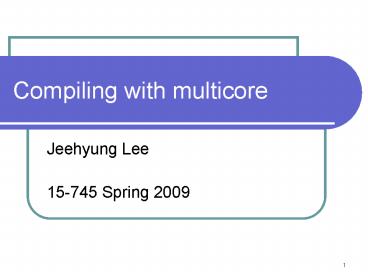Compiling with multicore - PowerPoint PPT Presentation
Title:
Compiling with multicore
Description:
With use of inter-core queue, threads can be decoupled. Efficiency high tolerance for latency ... Decide # of partitions (threads) ... – PowerPoint PPT presentation
Number of Views:52
Avg rating:3.0/5.0
Title: Compiling with multicore
1
Compiling with multicore
- Jeehyung Lee
- 15-745 Spring 2009
2
Papers
- Automatic Thread Extraction with Decoupled
Software Pipelining - Fully automatic
- Fine grained pipelining
- A Practical Approach to Exploring Coarse-Grained
Pipeline Parallelism in C Programs - Semi-automatic
- Coarse grained pipelining
3
First paper
- Automatic Thread Extraction with Decoupled
Software Pipelining - Guilherme Ottoni, Ram Rangan, Adam Stoler and
David August - From Princeton University
4
What is the paper about?
- Despite increasing uses of multiprocessors, many
single threaded applications do not benefit - Let the compiler automatically extract threads
and exploit lurking pipeline parallelism - Extract non-speculative and truly decoupled
threads through Decoupled Software
Pipelining(DSWP)
5
Why decoupled pipelining?
- Example
Linked list traversal
6
Why decoupled pipelining?
- DOACROSS
Iteration (LD latency communication latency)
7
Why decoupled pipelining?
- DSWP
One way pipelining
Iteration LD latency
8
DSWP
- Flow of data (dependency) is acyclic among cores
- With use of inter-core queue, threads can be
decoupled - Efficiency high tolerance for latency
9
DSWP Algorithm
- Build dependence graph
- Find strongly connected components (SCC)
- Create DAG of SCC
- Partition DAG
- Split codes into partitions
- Add flows to partitions
10
Build dependence graph
Include every traditional dependence (data,
control, and memory) extensions
11
Find SCC
- SCC Instructions that form a dependency cycle
in a loop - Instructions in SCC cannot be parallelized
1
1
2
2
1
2
12
Create DAG of SCCs
- Merge instructions within each SCC and update
dependency arrows
13
Partition DAG
- Partition DAG nodes into n partitions
- ( n lt of processors)
- Use heuristic to maximize load balance
- Decide of partitions (threads)
- Start filling in from partition 1 with nodes from
the top of DAG. - When the partition is stuffed (estimated by of
cycles), move on to next partition - Find the best of threads and its partition
14
Split codes and insert flows (done!)
- For each partition, insert code basic blocks
relevant to its contained SCC node - Add in codes for dependency flow
15
Result
- 19.4 speedup on important benchmark loops, 9.2
overall - When core bandwidth is halved
- Single threaded code slows down by 17.1
- DSWP code is still slightly faster than
single-threaded code running on full-bandwidth
core - Promising enabler for Thread-Level-Parallelism(TLP
)?
16
Second Paper
- A Practical Approach to Exploring Coarse-Grained
Pipeline Parallelism in C Programs - William Thies, Vikram Chandrasekhar and Saman
Amaransinghe - From MIT
17
What is the paper about?
- Despite increasing uses of multiprocessors, many
single threaded (Repeated) - Coarse grained pipelining is more desirable, but
is especially hard with obfuscated C codes - Let people define pipeline, and learn practical
dependencies in runtime
18
What is the paper about?
- Despite increasing uses of multiprocessors, many
single threaded (Repeated) - Coarse grained pipelining is more desirable, but
is especially hard with obfuscated C codes - Let people define stages, and learn practical
dependencies in runtime for streaming
applications
19
Interface
- Add annotations in the body of top loop
20
Dynamic analysis
- The system creates a stream graph according to
annotations.
How do they find dependencies?
21
Dynamic analysis
- Streaming applications tend to have a fixed
pattern of dataflow (stable flow) among pipeline
stages
22
Dynamic analysis
- Run the application on training examples, and
record every relevant store-load pair across
pipeline boundaries
This gives us practical dependencies
23
Interface
- Program shows a complete stream graph
- User decides if he/she likes this
- pipelining or not
- If yes, done!
- else, redo annotations. Iterate over until
satisfied
24
Actual pipelining
- When compiled, annotation macros emit codes that
will fork original program for each pipeline
stage
25
Result
- Average 2.78x speedup, max 3.89x on 4-core
- Seems unsound but practical (?)































